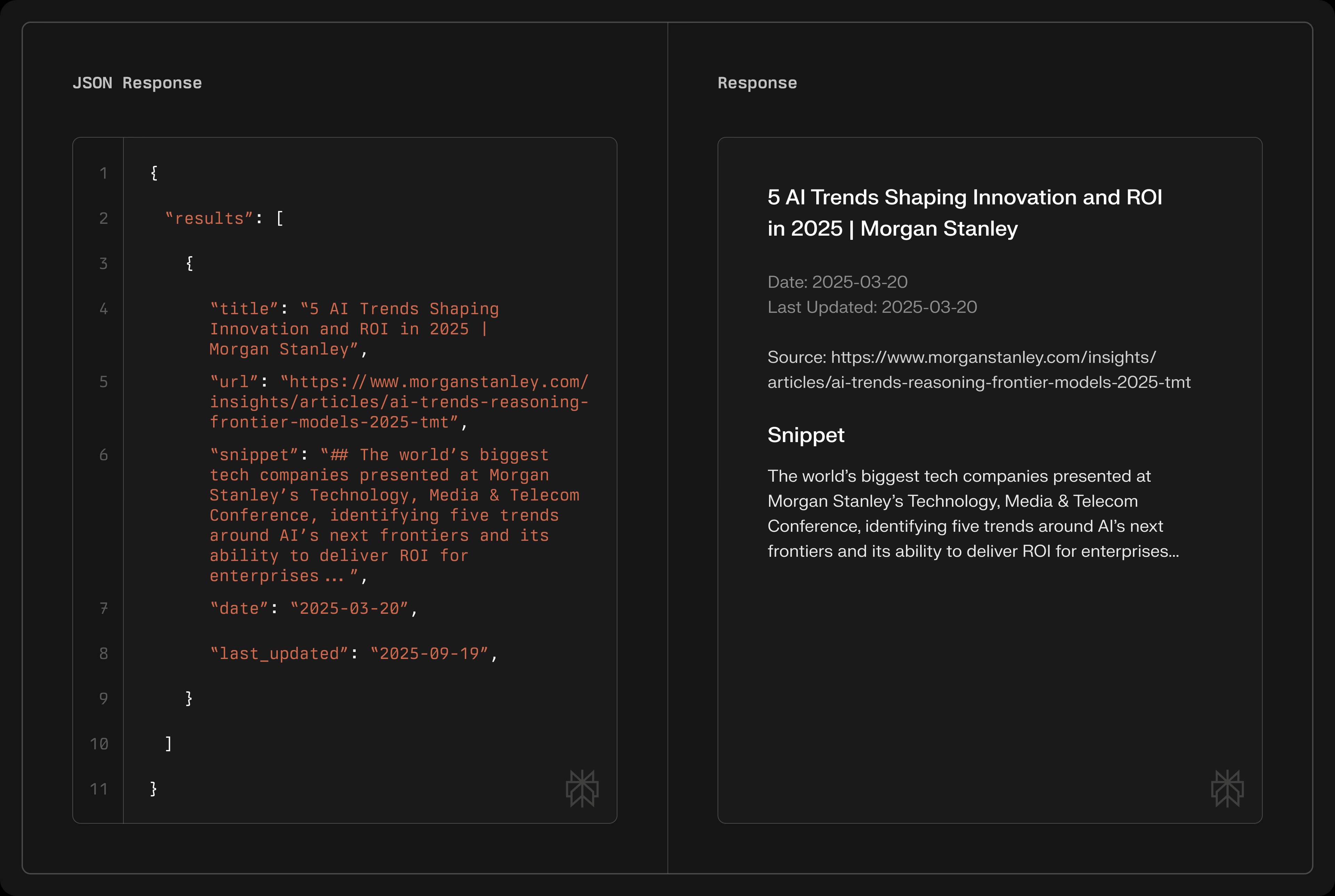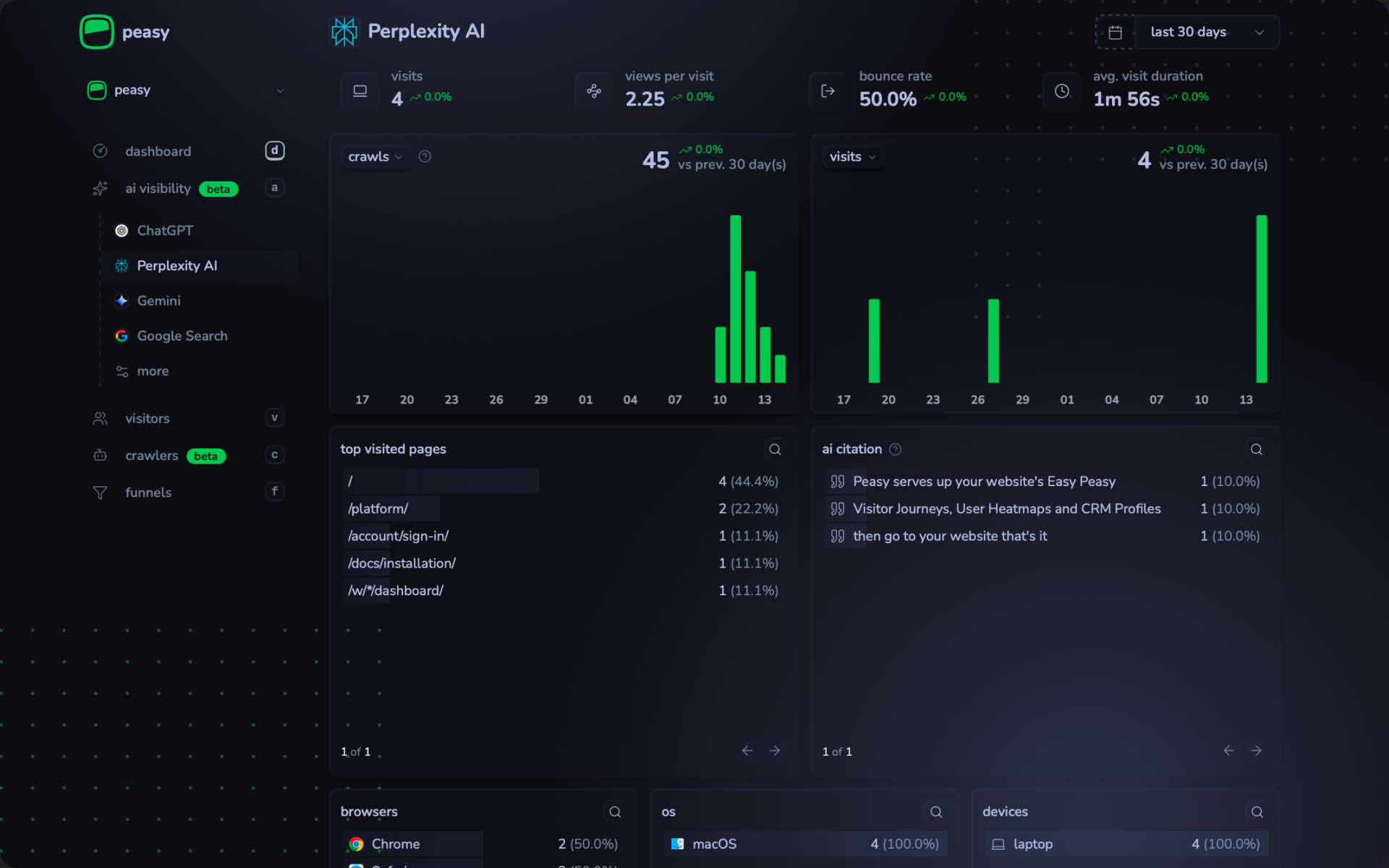- AI Search
- Perplexity
- AI Visibility
- Analytics
New Perplexity Search API Demands a Shift in AI Visibility Analytics
Perplexity's Search API cements AI as the future of search. This shift creates a new visibility challenge. Learn how Peasy analytics let you control your AI traffic, from crawler to conversion.


Team Peasy
The collective voice of Peasy, covering AI visibility, analytics and generative search optimization. LinkedIn

Perplexity Search API: What It Means for Your Brand’s AI Visibility and Search Traffic
Perplexity has announced the launch of its Search API, providing developers with direct access to the infrastructure that powers its public-facing answer engine. This move positions Perplexity as not only a consumer-facing search product but also as a platform level provider of search capabilities for third-party applications. For businesses, publishers and analytics professionals, this is a significant moment. It signals the maturation of AI search as a distinct channel and raises important questions about traffic attribution, visibility and competition with Google.
In this article, we analyze the announcement through three lenses: the strategic implications for Perplexity itself, the broader trajectory of AI search traffic compared to Google and the opportunities this creates for visibility measurement. Finally, we connect these developments to how Peasy helps brands track and understand traffic originating from generative AI platforms.
Perplexity’s Evolution From Consumer Tool to Infrastructure Provider
Since its launch, Perplexity has positioned itself as an AI-native answer engine that blends real-time web retrieval with large language models. Unlike static LLMs, Perplexity integrates live data, cites sources and structures answers in a way that resembles both a chatbot and a search engine. Its differentiator lies in transparency: citations are embedded directly in answers, providing verifiable attribution.
With the release of the Search API, Perplexity is extending this infrastructure outward. Developers can now integrate its search and answer capabilities into other applications, workflows and products. This shifts Perplexity from being only a destination website to becoming a backbone provider for AI-powered search experiences across the ecosystem.
The implications are twofold:
-
Traffic Redistribution. Instead of users visiting Perplexity.com directly, third-party applications can deliver Perplexity-powered answers inside their own environments. This creates new patterns of AI-origin traffic, often invisible to traditional analytics.
-
Platform Stickiness. By embedding itself in developer workflows and external applications, Perplexity increases its long-term relevance. It follows the path of Google, which moved from a search destination to a provider of APIs and embedded services (Maps, Search Ads, Cloud APIs).
AI Search Traffic vs. Google: A Shifting Landscape
For more than two decades, Google has dominated the discovery layer of the internet. Its core proposition has been simple: index the web, rank results and monetize intent through advertising. AI search introduces a fundamentally different interaction model. Users no longer sift through ranked lists of blue links, they receive direct answers synthesized from multiple sources.
This raises critical questions about traffic flows:
- Click Distribution. In Google Search, visibility is measured in impressions and click-through rates on ranked results. In AI search, the key metric is whether a brand is cited in the generated answer and whether that citation drives a click.
- Attribution Blind Spots. Many analytics platforms classify AI referrals as “direct” traffic, obscuring the role of AI in discovery. Without dedicated tracking, companies underestimate the impact of these referrals.
- Competition for Authority. While Google emphasizes page rank and backlinks, AI search systems prioritize relevance, authority and recency at the model level. This shifts optimization strategies away from traditional SEO toward structured data, clarity of content and AI-specific accessibility signals.
Google has responded with AI Overviews and later AI Mode, integrating generative answers into its own search interface. But Perplexity’s API announcement highlights that AI-native companies are moving faster, unbundling their infrastructure and distributing it through developer channels. This competition will accelerate shifts in how users find and interact with information.
How Perplexity Is Redefining AI Search Infrastructure
By offering its search infrastructure as an API, Perplexity moves into a new category: AI search-as-a-service. This positions it against both incumbents and other emerging players.
- Against Google. While Google retains unrivaled scale, Perplexity differentiates on transparency and developer friendliness. The API lowers barriers for startups and enterprises to build AI-driven experiences without depending on Google.
- Against OpenAI and Anthropic. LLM providers like GPT-4 and Claude offer general-purpose reasoning but lack integrated retrieval at Perplexity’s level. Perplexity fills this gap by blending generative reasoning with real-time data access.
- As a Traffic Origin. With every integration of its API, Perplexity extends its reach as a referrer of traffic. Even if users never visit Perplexity.com directly, its infrastructure can shape which links and brands are surfaced elsewhere.
This makes Perplexity both a competitor in the consumer search market and an enabler in the developer ecosystem. For businesses, the implication is clear: visibility in Perplexity’s ecosystem will matter not only on its own website but also across any application built on its API.
AI Traffic Trends: The Rise of Answer Engines
The Perplexity announcement should be viewed not as an isolated product update but as part of a wider shift in how traffic moves across the web. Generative AI platforms are no longer experimental add-ons to search, now they are becoming parallel gateways to information with their own rules of visibility, discovery and referral. Each new API, integration or feature release expands the reach of these systems and increases the share of user attention they capture away from traditional search engines. For brands and publishers, this means that measuring traffic cannot stop at Google Analytics or classic SEO metrics. AI visibility is emerging as a distinct channel, one that requires its own data, benchmarks and optimization strategies.
Perplexity’s move into infrastructure provision through its Search API highlights how quickly these changes are accelerating. When an answer engine makes its capabilities available to developers, the scope of AI-driven discovery extends far beyond its own domain. Answers powered by Perplexity will now appear inside third-party applications, vertical search tools, and enterprise workflows, multiplying the touchpoints where content can be cited and linked. This expansion also multiplies the complexity of attribution: the same underlying system may drive traffic from dozens of different interfaces, each with its own referral patterns. Understanding these trends is critical to interpreting what the API launch means in practice, and why brands must adjust their approach to analytics accordingly.
-
Growth of Generative Interfaces. Platforms like ChatGPT, Gemini and Claude are capturing billions of interactions monthly. Many of these bypass Google entirely, creating alternative pathways of discovery.
-
Citations as a New Click. In AI search, being cited is the equivalent of ranking on page one of Google. Without a citation, a brand remains invisible, no matter its presence on the open web.
-
Fragmentation of Sources. With Perplexity, Google and others building generative layers, traffic sources are fragmenting. This creates complexity for analytics, as visibility is distributed across multiple platforms with different referral behaviors.
-
Undercounted Impact. Internal data from Peasy shows that AI referrals often appear as “Direct” in traditional analytics dashboards. For some websites, this represents several percent of traffic already, a figure expected to rise as adoption increases.
Analytics and the Challenge of Measuring AI Visibility
The Perplexity API highlights a pressing issue: as AI search scales, measuring its impact becomes essential. Traditional analytics approaches fall short:
- Crawlers Skip Scripts. AI bots often bypass JavaScript, meaning browser-side script based trackers (Google Analytics, Plausible, etc.) undercount AI visits.
- Referrals Are Masked. Many AI answers pass traffic without referral headers, classifying visits as “Direct”.
- Attribution Complexity. Multiple agents, indexing bots, live query fetchers and training crawlers interact differently with websites. Without classification, it is impossible to separate discovery from consumption.
This is where Peasy’s AI visibility analytics enters. By combining crawler log analysis, user-agent detection and query parameter attribution, Peasy shows verifiable evidence of AI interactions. The result is a clear picture of both supply-side (crawler activity) and demand-side (referral traffic) visibility.
Analyze Perplexity Referral Traffic and citations with Peasy Analytics
Peasy has already been able to detect and classify referral traffic from Perplexity for some time. When a user clicks a cited link in a Perplexity answer and lands on a site, Peasy captures the referral headers and session metadata to confirm the origin. This has given companies a clear, verifiable view that Perplexity is not only surfacing their content but also driving measurable visits and conversions.
The launch of the Perplexity Search API changes the scope of what can be analyzed. Instead of relying only on downstream referral evidence, brands can now gain access to richer, structured signals about how Perplexity is discovering, citing and distributing their content. This deeper visibility makes it possible to connect the dots across the entire lifecycle of discovery: from crawler activity, to inclusion in Perplexity’s indexed knowledge, to citations in generated answers and finally to user clicks.
-
Expanded Traffic Sources. Until now, referrals from Perplexity could be tracked and attributed within Peasy. With the API powering third-party integrations, AI-origin traffic will come from a wider set of environments. With the Search API, attribution will gain even more precision and context.
-
Citations as Growth Signals. Peasy has already connected Perplexity citations to referral sessions and conversions. API access expands what can be analyzed, giving more granular context about the queries and interactions that drive discovery and measurable outcomes.
-
Benchmarking Across Platforms. Cross-platform benchmarking has been possible with Peasy by combining crawler activity and referral data. The Perplexity API adds more structured signals, strengthening comparisons with ChatGPT, Gemini and others and sharpening the ability to spot optimization opportunities.
The dashboard example below illustrates this process: crawler activity is tracked over time, top-cited pages are identified and referrals are mapped to engagement metrics. With the added detail APIs unlock, AI visibility moves from operational tracking to actionable intelligence.

The Bigger Picture Behind the Perplexity Search API
The release of the Perplexity Search API represents more than a technical milestone. It signals a structural change in how discovery, visibility and traffic will work in the AI era. Several long-term dynamics emerge:
- AI as a Parallel Discovery Layer. Google remains dominant, but AI search engines like Perplexity are establishing themselves as parallel entry points to information.
- Visibility Redefined. Ranking in Google SERPs is no longer enough. Brands must ensure they are cited in AI answers and visible in generative summaries.
- Analytics as a Moat. Brands that measure AI visibility gain an edge, as they can optimize content for AI discovery and prove ROI. Those that ignore it risk operating blind to a growing share of demand.
- Ecosystem Integration. With its API, Perplexity is betting that its infrastructure will underpin not just its own site but also a wide range of AI-powered experiences. For businesses, this means that visibility inside Perplexity has ripple effects across multiple channels.
Understanding Perplexity’s Impact on AI Search and Brand Measurement
Perplexity’s Search API marks a turning point. It transforms the company from a standalone answer engine into a platform provider, deepening its role in the AI search ecosystem. For brands, the implications are clear: AI platforms are not fringe traffic sources but emerging gateways that shape how users find and evaluate brands.
The challenge is measurement. Without tools designed for AI environments, traffic from platforms like Perplexity remains invisible or misclassified. Peasy fills this gap by providing a unified framework to track crawlers, classify agents and attribute referrals.
As AI adoption accelerates, visibility will no longer be defined only by Google rankings. It will be measured by citations in AI answers, crawler activity in AI datasets and referral traffic from generative platforms. The Perplexity Search API underscores this shift and Peasy ensures that businesses can see, measure and act on it.
Attribute every AI visit to revenue and growth.
Easy setup, instant insights.
based on real user feedback